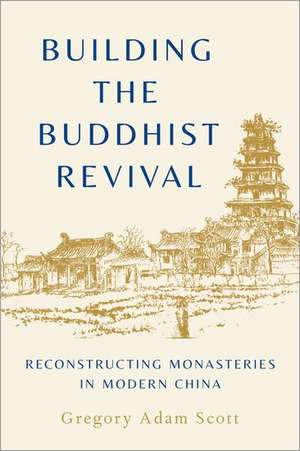Building the Buddhist Revival: Reconstructing Monasteries in Modern China
Autor Gregory Adam Scotten Limba Engleză Hardback – 22 apr 2020
Preț: 574.64 lei
Preț vechi: 782.03 lei
-27% Nou
Puncte Express: 862
Preț estimativ în valută:
109.96€ • 119.81$ • 92.66£
109.96€ • 119.81$ • 92.66£
Carte tipărită la comandă
Livrare economică 12-18 aprilie
Preluare comenzi: 021 569.72.76
Specificații
ISBN-13: 9780190930721
ISBN-10: 0190930721
Pagini: 264
Dimensiuni: 236 x 160 x 25 mm
Greutate: 0.5 kg
Editura: Oxford University Press
Colecția OUP USA
Locul publicării:New York, United States
ISBN-10: 0190930721
Pagini: 264
Dimensiuni: 236 x 160 x 25 mm
Greutate: 0.5 kg
Editura: Oxford University Press
Colecția OUP USA
Locul publicării:New York, United States
Recenzii
This volume will hopefully generate deeply fruitful further discussion and research.
This volume is invaluable to anyone seeking to understand contemporary Chinese Buddhism.
Richly detailed... Building the Buddhist Revival will be useful for scholars of Chinese Buddhism, modern Chinese history, and monastic institutions.... Highly recommended.
Through its innovative perspective on the restoration of temples and monasteries, this book contributes towards a history beyond that of great men and great texts, and towards a historiography that can cope with complex developments over longer periods.
Building the Buddhist Revival is a fine book with exceptional detail that makes a compelling case for just how important Buddhist monasteries were in China's past politically, socially, economically, and how even today they play a significant role in Chinese Communist Party narratives about what constitutes China proper. Historians of China and scholars of Chinese Buddhist studies and religious studies will find great value in Gregory Adam Scott's work.
...this study of Buddhist monasteries is an enjoyable and intriguing analysis of the recovery of Buddhist sites. In particular, Scott's focus on the complicated social networks surrounding the destruction and rebuilding of temples that occurred during this tumultuous period is a welcome addition to Chinese Buddhism.
This book moves beyond the customary narrative of Buddhist decline in the period from 1866 to 1966, by focusing on reconstruction and change as evidence of a lively religious culture. The author describes monastic restorations as collective projects by devout local communities under the leadership of charismatic individuals. He provides a richly textured history of Buddhist institutions, as well as an unusual window into the whirlwinds of recent Chinese history.
Destroying and building are two sides of a same coin. There are studies of early Buddhists building monasteries all over China; and, more recently, of their modern destruction. Now Gregory Scott offers the first history of how Buddhists kept building and rebuilding in the age of destruction, living up to their vocation as fundraisers, planners, and architects. This is a must-read for anyone who understands that religion is largely about places and temples.
One of the most significant indicators of Buddhist revival is the health of its monasteries. This is the first book in English on the reconstruction of Buddhist monasteries in China between 1866 and 1966. The author discusses the motivations, resources and means to reconstruct monasteries after they had been destroyed as a result of wars and neglect. It makes major contributions to Chinese Buddhist studies and Chinese history.
This volume is invaluable to anyone seeking to understand contemporary Chinese Buddhism.
Richly detailed... Building the Buddhist Revival will be useful for scholars of Chinese Buddhism, modern Chinese history, and monastic institutions.... Highly recommended.
Through its innovative perspective on the restoration of temples and monasteries, this book contributes towards a history beyond that of great men and great texts, and towards a historiography that can cope with complex developments over longer periods.
Building the Buddhist Revival is a fine book with exceptional detail that makes a compelling case for just how important Buddhist monasteries were in China's past politically, socially, economically, and how even today they play a significant role in Chinese Communist Party narratives about what constitutes China proper. Historians of China and scholars of Chinese Buddhist studies and religious studies will find great value in Gregory Adam Scott's work.
...this study of Buddhist monasteries is an enjoyable and intriguing analysis of the recovery of Buddhist sites. In particular, Scott's focus on the complicated social networks surrounding the destruction and rebuilding of temples that occurred during this tumultuous period is a welcome addition to Chinese Buddhism.
This book moves beyond the customary narrative of Buddhist decline in the period from 1866 to 1966, by focusing on reconstruction and change as evidence of a lively religious culture. The author describes monastic restorations as collective projects by devout local communities under the leadership of charismatic individuals. He provides a richly textured history of Buddhist institutions, as well as an unusual window into the whirlwinds of recent Chinese history.
Destroying and building are two sides of a same coin. There are studies of early Buddhists building monasteries all over China; and, more recently, of their modern destruction. Now Gregory Scott offers the first history of how Buddhists kept building and rebuilding in the age of destruction, living up to their vocation as fundraisers, planners, and architects. This is a must-read for anyone who understands that religion is largely about places and temples.
One of the most significant indicators of Buddhist revival is the health of its monasteries. This is the first book in English on the reconstruction of Buddhist monasteries in China between 1866 and 1966. The author discusses the motivations, resources and means to reconstruct monasteries after they had been destroyed as a result of wars and neglect. It makes major contributions to Chinese Buddhist studies and Chinese history.
Notă biografică
Gregory Adam Scott received his PhD from Columbia University, was previously a research fellow at the University of Edinburgh, and is currently lecturer at the University of Manchester. Originally from Canada, he is a historian of religion in modern China, particularly Buddhism.
